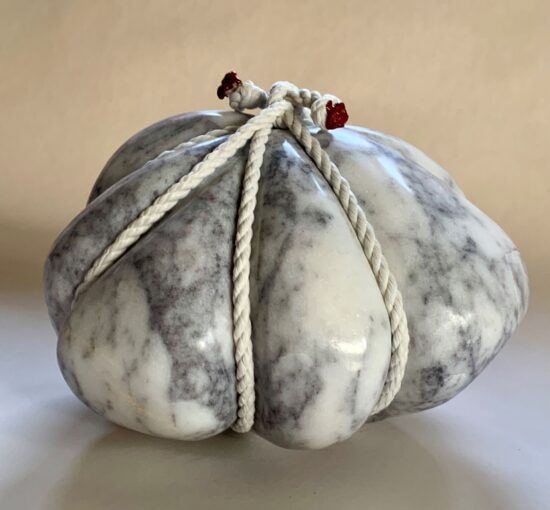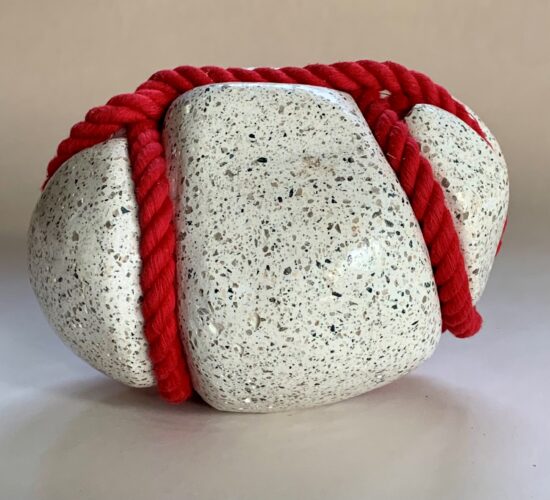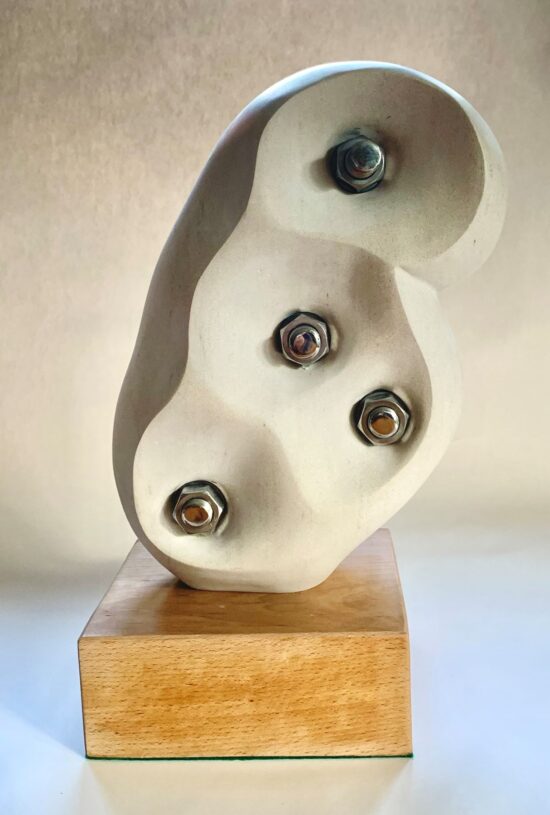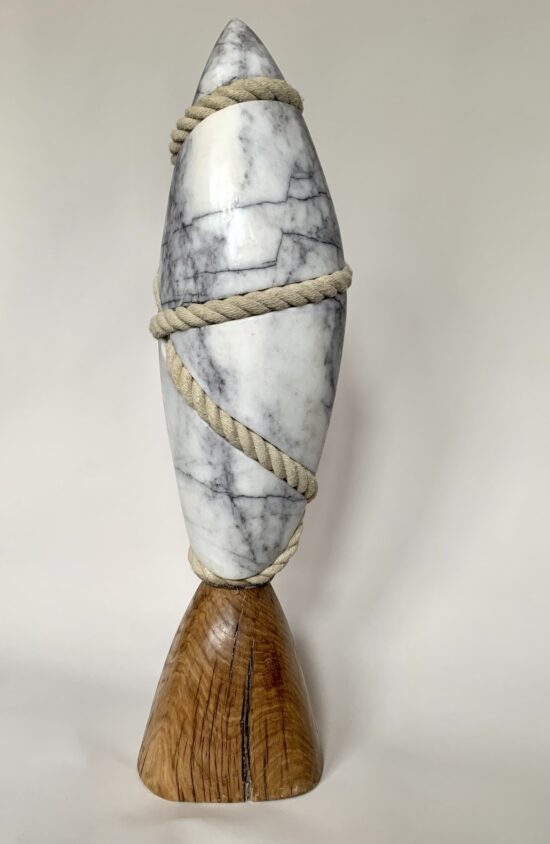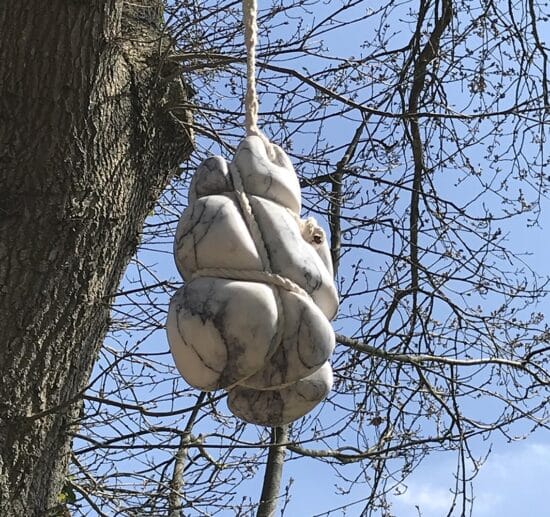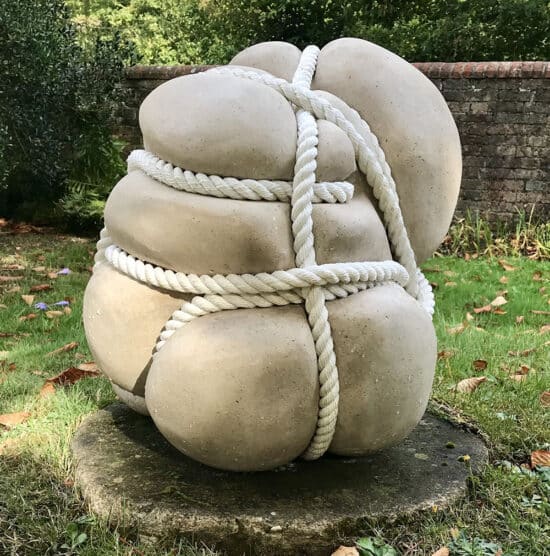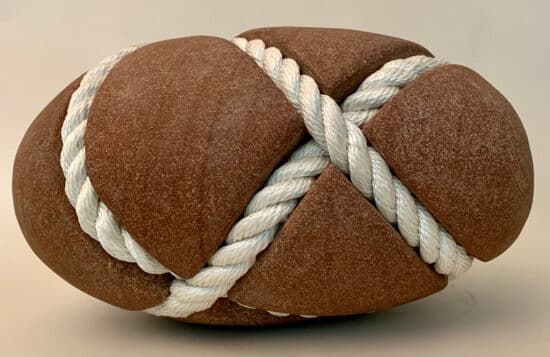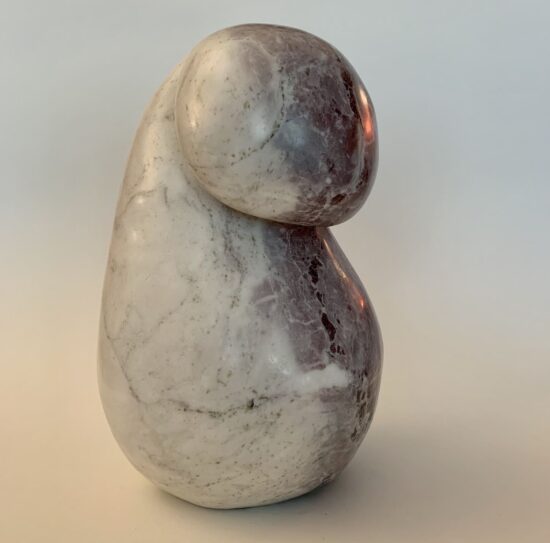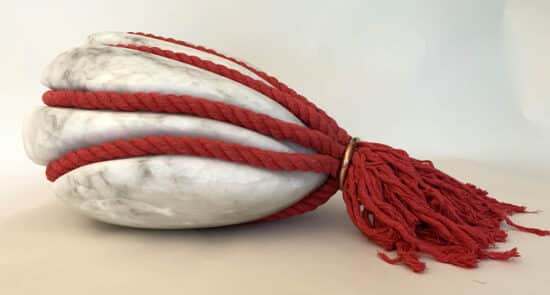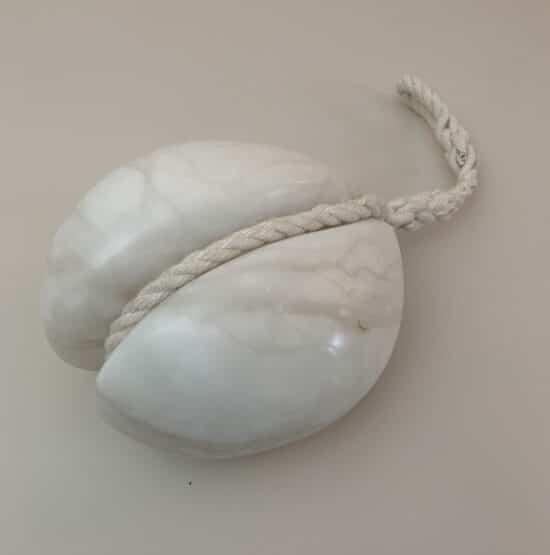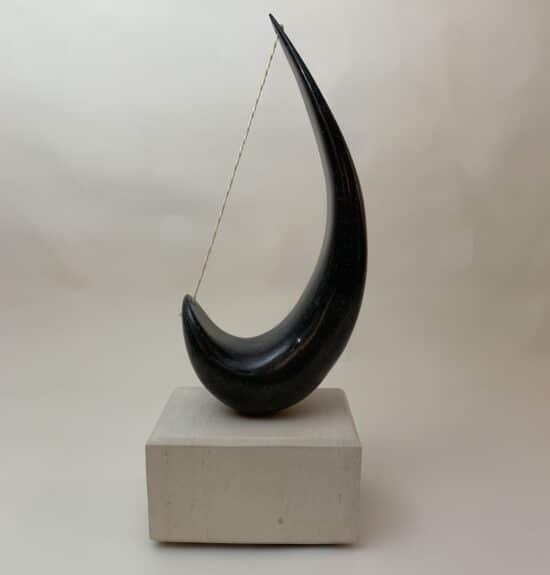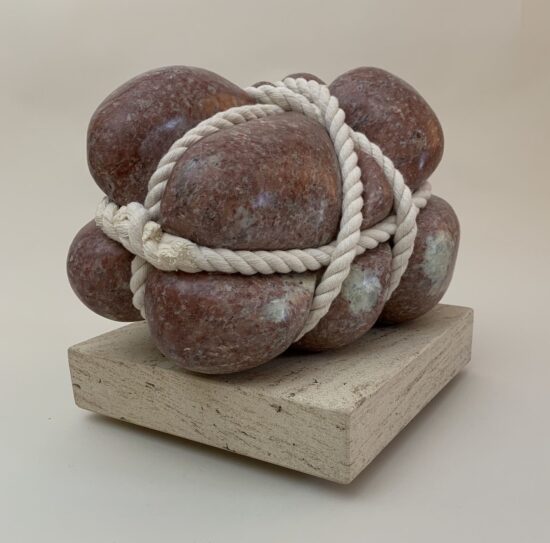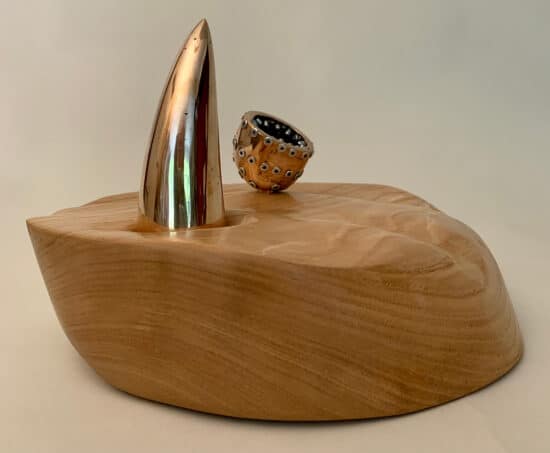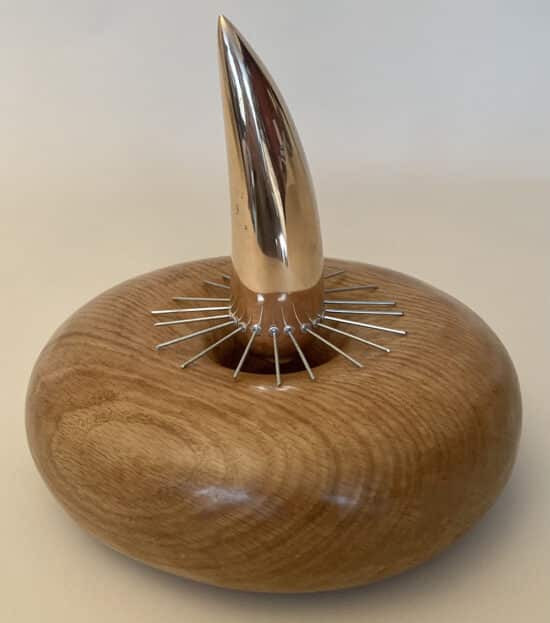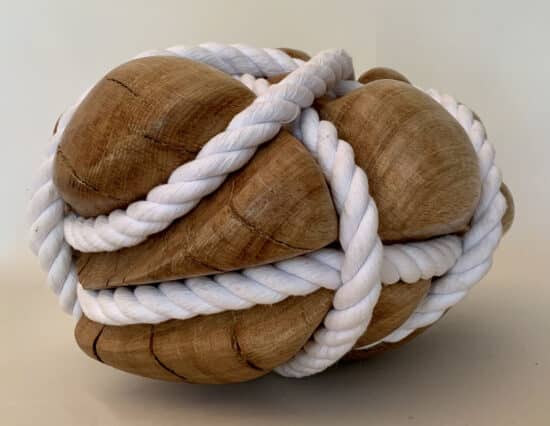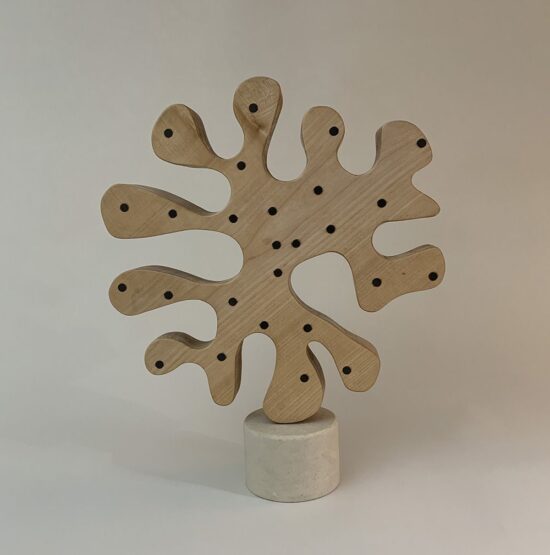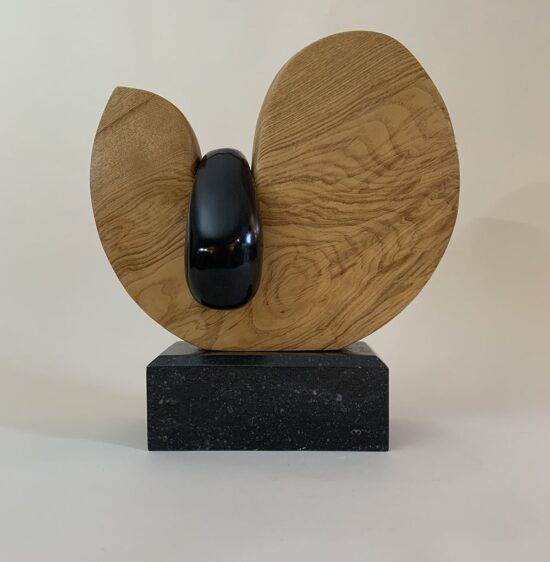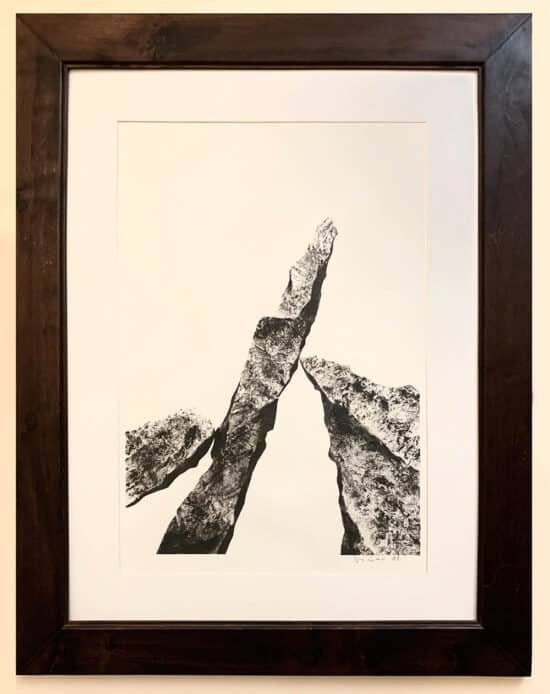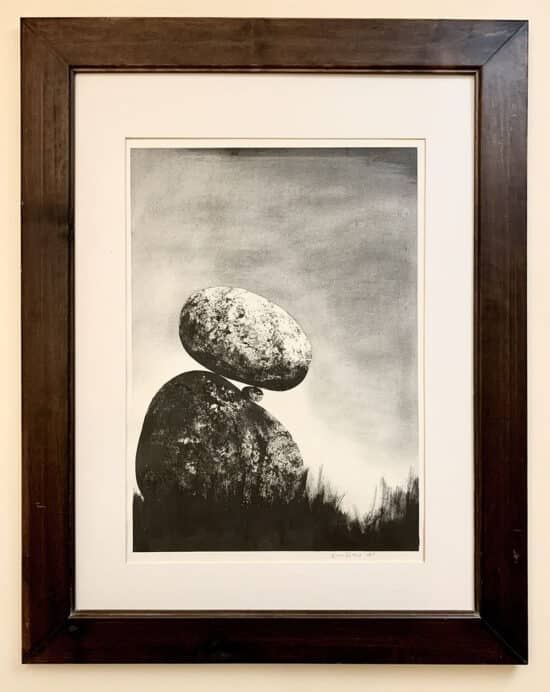Stone sculptures
Wood sculptures
Bronze sculptures
Drawings
Biography
The contemporary abstract sculptures of Peter Brooke-Ball surprise the observer with their simple yet ambiguous beauty. The artist brings together and initiates a dialogue of stark contrasts between materials that are dissimilar from each other, using primarily stone and rope.
The passion for sculpture and the choice of stone
British artist Peter Brooke-Ball lives and works in the Sussex countryside, just a handful of kilometres south of London. He was born in India in 1951, the country where he spent his childhood, with its people and culture still influencing him to this day. On returning to England, he developed a passion for art and sculpture, studying at four art schools and universities. During the 1980s he moved away from the world of art, working as an author and editor, publishing 14 non-fiction works.
Fifteen years later he returned to sculpture, which he has been dedicated to ever since on a full-time basis. His contemporary abstract sculptures have not always used stone, as the artist started out by exploring the sculptural possibilities of other materials such as ciment fondu, plaster and concrete, then weaving in more malleable materials such as leather, canvas and lead. The attraction for the use of elements with different physical characteristics has been a hallmark of his artistic practice since the beginning.
The transition to working with stone has involved a large investment from the artist in terms of equipment, tools and workspace. The choice of this material, which quickly became his favourite, is justified by an artistic interest as well a scientific one: Peter Brooke-Ball holds a degree in Earth Sciences and also has a large collection of rocks, minerals and fossils. For his sculptures today the artist uses a wide variety of stones and rocks: alabaster, limestone, soapstone, sandstone, travertine along with Portuguese, Turkish and Italian marble.
Contemporary abstract sculptures between sensuality and enigma
“My overriding passion is purity and simplicity. I strip away superfluous marks and decoration to express simple, honest ideas. What’s left can be a little scary but that is part of the purpose – to unsettle the viewer.”
The works of Peter Brooke-Ball have an immediate beauty: the curved forms of stone or wood give them an organic aspect, and the textures of materials become smooth and sensual in the hands of the artist, to the point of creating a tactile desire. The relationship to touch is sought out by the contemporary sculptor, who states: “If sculpture isn’t touched, I believe that it is only half understood – it is only when a piece is handled that some of the more subtle undertones are revealed.“
As a result of the use of rope which binds, restrains, and appears to ‘suffocate’ the stone, his contemporary abstract sculptures trigger emotional and intellectual reactions that are strong, complex and profound. Desires, fears, memories, nightmares, instincts and anxieties that were hidden and latent in the observer begin to surface, awakened by indirect references to cruelty, exploitation or pain. The interpretation of these works is not obvious, but the artist sees each piece as a precious thought that must be tied and held to protect it, and not let it slip away. In addition, the contrasting yet intimate connection between rope and stone challenges the relationship of strength and weakness between the two materials. All of these elements contribute to making the artist’s works extremely enigmatic, sometimes troubling and disturbing, at other times amusing and playful.
Since the 1900s, Peter Brooke-Ball has exhibited his contemporary sculptures in galleries, fairs and sculpture gardens mostly in the United Kingdom. His works are part of private collections throughout the world as well as public collections such as those of the Museo Municipal de Orense (Spain) and the Taunton and Somerset NHS Trust Musgrove Park Hospital (United Kingdom). His work was featured in a BBC documentary in 2016. Since 2007, the artist has been a member of the Royal Society of Sculptors (MRSS), an English organisation that promotes excellence in sculpture.
CV
Education
- 1971-1972 Hammersmith School of Art
- 1974-1975 Somerset College of Art
- 1975-1978 Bath Academy of Art
- 1979-1980 University of Exeter
Awards & Residencies
- SOLO AND TWO-PERSON EXHBITIONS:
- 2016 – Brewin Dolphin Show Garden, Chelsea Flower Show (Matthew Childs Garden Design), London, UK
- 2015 – Nynehead Court, Devon, UK
- 2012 – GX Gallery, London, UK
- 2011 – GX Gallery, London, UK
- 2011 – The Avenue, London, UK
- 2011 – View Gallery, London, UK
- 2011 – Cloisters, London, UK
- 2010 – GX Gallery, London, UK
- 2009 – GX Gallery, London, UK
- 2008 – GX Gallery, London, UK
- 2007 – GX Gallery, London, UK
- 2006 – Betty Morton Gallery, London, UK
- 2005 – Betty Morton Gallery, London, UK
- 2004 – Cloisters, London, UK
- 2003 – Escape, Herne Hill, London, UK
- 2002 – Briffa & Co. Business Design Centre, London, UK
- 2002 – Cloisters, London, UK
- 2001 – Ferndales Restaurant and Gallery, London, UK
- 2000 – Cloisters, London, UK
- 2000 – Ferndales Restaurant and Gallery, London, UK
- 2000 – British Cement Association, Berkshire, UK
- 1999 – Kingsgate Gallery, London, UK
- 1999 – Cloisters, London, UK
- 1998 – Museo Municipal de Orense, Spain
- 1997 – Alternative Arts Gallery, London, UK
- GROUP EXHBITIONS:
- 2021 – Farleys Farm and Gallery, East Sussex, UK
- 2019 – Chiddingly Art Festival, East Sussex, UK
- 2018 – Affordable Art Fair, London, UK (Nick Bowlby Gallery)
- 2017 – Delamore Arts, Devon, UK
- 2017 – Affordable Art Fair, Battersea, London, UK (Nick Bowlby Gallery)
- 2016 – onform 16, Oxfordshire, UK
- 2015 – rhs Rosemore, Devon, UK
- 2015 – Contemporary Sculpture, Newby Hall, Yorkshire, UK
- 2015 – ‘Sculptural’, William Benington Gallery, Devon, UK
- 2015 – Affordable Art Fair, Battersea, London, UK (The Art Movement)
- 2014 – The Art Movement Gallery, London, UK
- 2014 – Art of Angel/ArtBelow, Angel Underground and Candid Arts, London
- 2013 – onform, London, UK
- 2013 – Affordable Art Fair, Battersea, London, UK (The Art Movement)
- 2013 – Chelsea Flower Show, London, UK (Marshall Murray)
- 2013 – ‘Sculptural’, William Benington Gallery, Devon, UK
- 2013 – Riverhill House, Sevenoaks, Kent (Marshall Murray)
- 2013 – Ube International Sculpture Biennale (sculpture models), Ube, Japan
- 2013 – London Art Fair (The Art Movement)
- 2013 – Rufus Knight-Webb Gallery, London, UK
- 2012 – London Art Fair (The Art Movement)
- 2012 – onform 12, Oxfordshire, UK
- 2012 – Affordable Art Fair, Hampstead, London, UK (GX Gallery)
- 2011 – Hannah Peschar Sculpture Garden, Surrey, UK
- 2011 – Sculpture at the Grove, Hertfordshire, UK
- 2011 – London Art Fair (The Art Movement)
- 2011 – Affordable Art Fair, Hampstead, London (the Art Movement)
- 2011 – Windsor Art Fair (GX Gallery)
- 2011 – Art London (The Art Movement)
- 2010 – Hannah Peschar Sculpture Garden, Surrey
- 2010 – Art on The Block, Taunton, Somerset
- 2010 – Art London (The Art Movement)
- 2010 – Affordable Art Fair, Battersea, London, UK (The Art Movement)
- 2009 – Edward Alleyn Building/Michael Croft Theatre, London, UK
- 2008 – Art for Life, Musgrove Park Hospital, Somerset, Christies, London, UK
- 2008 – Affordable Art Fair, Battersea, London, UK (The Art Movement)
- 2008 – Art London (The Art Movement)
- 2008 – Red Dot Art Fair, London, UK (GX Gallery)
- 2007 – Dulwich Festival, London, UK
- 2006 – GX Gallery, London, UK
- 2006 – Dulwich Festival, London, UK
- 2006 – Dulwich Art Fair, London, UK (Betty Morton Gallery)
- 2005 – Kunst-Event, Rotterdam, Netherlands
- 2005 – Betty Morton Gallery, London, UK
- 2004 – On the Wall, Olympia, London, UK
- 2003 – Alan Klukow Fine Art, Sunningdale, Berkshire, UK
- 2003 – The Arthouse at Westbourne, Hampshire, UK
- 2003 – The Pride of the Valley Sculpture Park London Exhibition, London, UK
- 2003 – Fresh Art 2003, London, UK
- 2002 – Betty Morton Gallery, Brixton, UK
- 2001 – Fresh Art 2001, London, UK
- 2001 – Artizin Contemporary Fine Arts Gallery, Edinburgh
- 2001 – Battersea Contemporary Arts Fair, London, UK
- 2000 – Gardens of Gaia Sculpture Park, Kent, UK
- 2000 – ‘Outdoor Sculpture’, Beatrice Royal Contemporary Arts Gallery, Hampshire, UK
- 2000 – ‘Art in the Garden’, Sir Harold Hillier Gardens and Arboretum, Hampshire, UK
- 2000 – Paperleaf Arts Fair, London, UK
- 2000 – ‘Wind and Sail’, Beatrice Royal Contemporary Arts Gallery, Hampshire, UK
- 1999 – ‘Off Your Trolley’, Old Truman Brewery, London, UK
- 1998 – ‘Boundaries of Landscape’, Small Mansions Art Gallery, London, UK
- 1998 – ‘New Images’, Axis, London, UK
- 1998 – Gardens of Gaia, Kent, UK
- 1997 – ‘Riverside Collection’, Museo Municipal de Orense, Spain
- 1996 – ‘New Labour’, The Riverside Studios, London, UK
- 1996 – RAG in Spain, Museo Municipal de Orense, Spain
- 1995 – ‘The RAG Show’, Fulham Palace, London, UK
- 1995 – ‘The Way We Live Now’, The Gardener Gallery, University of Brighton
- 1994 – ‘RAG ‘94’. Waterman’s Art Centre, London, UK
- 1993 – Manchester Academy of Fine Arts
- COLLECTIONS:
- The Collection of Modern and Classical Art, Museo Municipal de Orense, Spain
- Taunton and Somerset NHS Trust (Musgrove Park Hospital)
- Mori Building Company, Tokyo, Japan
- Gynaecology Ultrasound Centre, London, UK
- Thompson + Baroni Architects, London, UK
- Ferndales Restaurant and Gallery, London, UK
- Private collections in England, Scotland, Hungary, Canada, New Zealand, US, and Italy

